Feeling dissatisfied with life? Join a convent! Okay, without authentic religious belief and commitment, that’s probably not a great idea. But economist Tomáš Janotík explains that Benedictine nuns do seem to be significantly happier than their counterparts in secular society.
Janotík surveyed 154 nuns from sixteen Benedictine monasteries across Germany. He then compared their answers to data from a nationwide survey, looking at all women and at Catholic women specifically. His results showed that the nuns reported much higher levels of satisfaction with life than either women in general or Catholic women. The nuns also said they were happy more often and angry, worried, or sad less often than either segment of the general population reported.
Part of the difference may lie in the nuns’ health, and in their attitudes toward health. Nuns reported significantly greater satisfaction with their health than the general population, particularly later in life. At the same time, differences in self-reported health had less effect on their overall life satisfaction. In other words, those living with illness or disability typically weren’t brought down emotionally in the same way that their secular-world counterparts were.
Work is a key part of the Benedictine monastic life, and Janotík found it also contributed to the nuns’ happiness. Nuns were quite a lot happier with their work lives compared with the general population. They also reported more satisfaction when it came to sleep and accommodations. In addition, they generally said they were able to control their lives and had a strong sense of belonging and meaning.
Perhaps most surprisingly, the nuns defied a pattern in human happiness that’s extremely common across human societies. Social scientists have found that, on average, adults experience a decline in life satisfaction in middle age, which then reverses itself later in life. That’s sometimes described as a happiness U-curve. In the data for German women, life satisfaction declined between ages forty and sixty and then recovered. For the nuns, however, this measure of happiness continued rising fairly steadily throughout their adult lives.
One reason that might account for this difference is that nuns don’t marry or have kids—choices which arguably could make life more stressful and difficult in middle age. But Janotík found that the happiness curves for unmarried and childless woman among the general German population look a lot more like the U-curve than like the continuing upward slope of the nuns.
“This suggests that the decision to join the monastic community leads to permanent increase in satisfaction with life, which continues to rise even after many years spent in the monastery,” he writes.
Weekly Digest
Janotík never quite determines why nuns don’t seem to suffer from midlife crises. Other scholars have linked the typical U-curve pattern to disappointed expectations of career and life achievements, followed by a recalibration of what’s important in later years. Perhaps nuns are working with different ideas about what kinds of satisfactions they can expect from life. That might be something any of us could emulate, even if we have no interest in monasticism.







